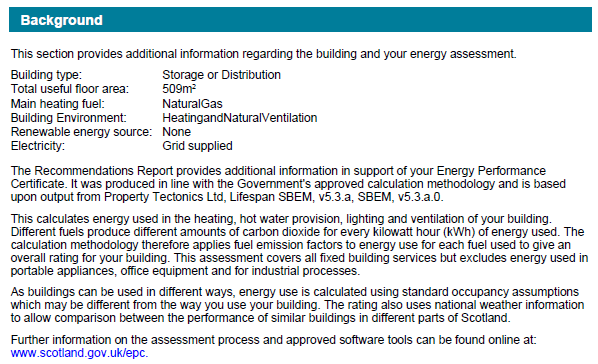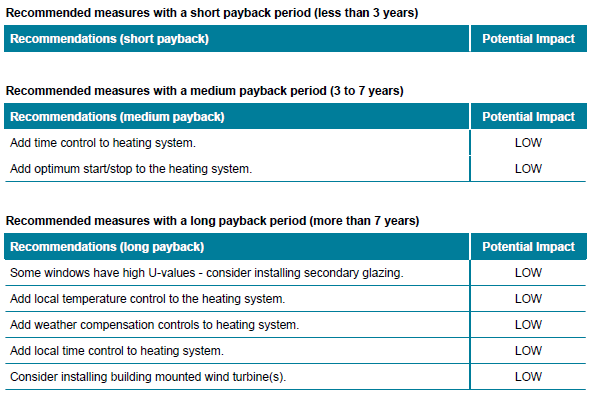Energy Performance
- ryanjones00
- Sep 1, 2020
- 4 min read
Perspective's quick guide to Energy Performance Certificates

What is an EPC?
An Energy Performance Certificate (EPC) is used to outline the property's energy expenditure and carbon emissions per year. The Certificate provides recommendations on how to improve the shortfalls, with potential target ratings should they be undertaken.
We will be dissecting the typical non-domestic EPC into sections in order to understand the information that can be taken from these.
The colour scheme and ratings.
EPCs tell you how energy efficient a building is and give it a rating from A (very efficient) to G (Very Poor). It is possible for newer builds to satisfy A+ New Zero Carbon. However, this involves considerations to design and efficient systems during the construction process.
The example EPC below shows the current rating of C (Between 31-45) for its building type - Storage/ Distribution.

Energy & Carbon Dioxide
The energy assessor will pay close attention to the building fabric, design and services during the site survey. This data is essential to outline the buildings performance rating. The collected information will be systematically input into an interface using a simplified building energy model (SBEM) essentially recreating the building and its dedicated services.
Once the input has been completed, the EPC will provide an approximate indicator on the energy use and carbon dioxide emissions of that property. The EPC extract below shows the Energy measured in kWh (Kilowatt-hours) per m2 per year and the CO2 (Carbon Dioxide) measured in KgCO2 per m2 per year. This information will fluctuate depending on the property type and services.

Benchmark
The benchmark provides some information into the new build comparative for a building of this nature. This example is classified as Storage/ Distribution. If built to current regulations at the date of issue, this would achieve an A performance rating. This is a clear example of how much efficiency and sustainability is being considered for new builds and developments.

Recommendations
The recommendations at the bottom of an EPC are a brief summary of the improvement measures which have been selected by the assessor. During the EPC input process, these improvements will be considered, and a new performance rating produced. This has been outlined in the main EPC above as 'potential rating - 42 C'. Although this is a minor improvement in this example, the potential rating can vary significantly depending on the building design, fabric type and potential to upgrade existing services.
The example below demonstrates four improvements that can be undertaken to meet this potential rating. Here we see that three recommendations relate to services with one suggesting an improvement to the building fabric.

Recommendations Report
This is usually around five pages of additional information which is appended to the Energy Performance Certificate above. It is important that this is provided with the EPC in order to outline additional key information for client consideration.
The background section will outline the following:
Building type - The classification of building function
Total useful floor area - Shown here as 509m2 this is what the model will apply the kWh usage & CO2 emissions too.
Main Heating Fuel - In this example Natural Gas is supplied to the premises
Building Environment - Heating and natural ventilation present.
Renewable Energy - None in this example.
Electricity - Grid Supplied in this example.

The recommendations discussed above are outlined in this section of the report. They will be checked and selected appropriately by the energy assessor and categorised into four headings:
Short Payback Period - Less than three years
Medium Payback Period - Between 3 - 7 years
Long Payback Period - More than seven years
Other Improvement Measures - These may be additional improvements or comments made by the energy assessor.
The additional information that can be seen in this example is the Potential Impact. This outlines the impact that these recommendations will have on the building performance. As we discussed above, the four selected actions improved the potential rating by 1 point (43 - 42). Thus the impact these options below will have on the property has been classified as Low.
The Payback is calculated in the model using data provided by 'Good Practice Guides and Carbon Trust Survey Reports'.
Each property is different and a varying degree of improved performance will be available.

Section 63 (Scotland)
The Scottish Government implemented the Section 63 to target the energy performance and greenhouse gas emissions of non-domestic buildings from 1st September 2016. This is an essential section of the report as it will indicate if your building is subject to these requirements.
Usually, this is triggered by the sale or lease to a new tenant, similar to the EPC. However, if the building is over 1,000m2 and built prior to the 2002 Building Regulations, then it will require the additional section 63 action plan in addition to the EPC.
This EPC example is 509m2 and excluded from these requirements as outlined in the extract below:

So what is the Action Plan?
The Action Plan is predominantly a 'target for improvement' which focuses on the carbon and energy performance of the building. The recommendations in this report are met through physical upgrading and modernising.
Once the Action Plan has been drafted, thorough discussions should be had between the building Owner and Assessor to ensure that the package of works required to meet the government target requirements can be undertaken. Once this has been agreed and finalised, the Owner has two options:
Carry out the works specified in the Action Plan
or
2. Defer improvement works.
If they choose to carry out the works identified in the Action Plan, this will trigger a timescale of 42 months in which the works must be satisfied. The assessor will require to attend site and review these works ensuring they have been carried out. A new EPC and Action Plan will be produced to update the superseded documents. There are fines in place if failure to satisfy the action plan and improvement works are not met in the allotted timeframe. Owners should consider the design stage and timescales required to carry out the agreed works.
If the owners choose to Defer the improvement works, they must instruct a Display Energy Performance Certificate (DEC). This is required to be updated annually until the improvement works are carried out.
The EPC and Action Plan must be made available to /prospective buyers or tenants and provided to new owners or tenants.'
Additional information can be found at the Scottish Government website below.
Please feel free to get in touch should you require advice or assistance with Non-domestic Energy Performance or Section 63. Perspective Building Consultancy has Approved Energy Assessors who can guide you through the Government energy requirements.








Comments